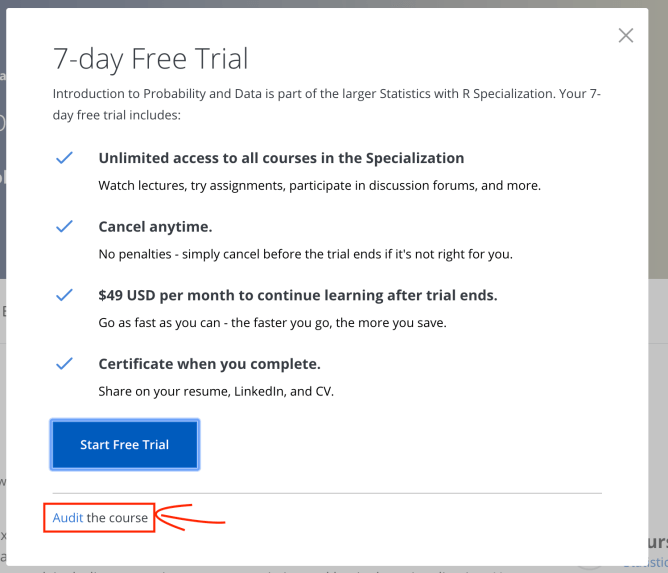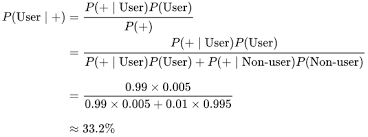Latest news about Bitcoin and all cryptocurrencies. Your daily crypto news habit.
 Photo by Wes Hicks on Unsplash
Photo by Wes Hicks on Unsplash
It feels impossible to keep up with every new concept and technology in data science and machine learning. You have multiple languages, libraries and design principles.
We have written pieces on different resources that can help data professionals keep up to date with all the various technologies. However, many of these courses cost money.
But coursera offers an opportunity to take online courses for free from actual colleges and educational institutions. This allows you to get deeper understanding of concepts like machine learning, deep learning, statistics, etc.
The one problem is coursera has hundreds of machine learning courses, so it can be hard to filter out which ones are worth taking. So we have listed out our personal favorites!
Tip : Coursera can make it seem like the only option is to purchase the course. But they do have an audit button on the very bottom. Now, if you appreciate Coursera, by all means, you should purchase their specialization, I am still uncertain how I feel about it. But, I do love taking Coursera courses.
Select the audit course option to not pay for the course.
1. Introduction to Probability and Data
This course introduces you to sampling and exploring data, as well as basic probability theory and Bayes’ rule. You will examine various types of sampling methods, and discuss how such methods can impact the scope of inference. A variety of exploratory data analysis techniques will be covered, including numeric summary statistics and basic data visualization. You will be guided through installing and using R and RStudio (free statistical software), and will use this software for lab exercises and a final project. The concepts and techniques in this course will serve as building blocks for the inference and modeling courses in the Specialization.
Introduction to Probability and Data | Coursera
In this Specialization, you will learn to analyze and visualize data in R and create reproducible data analysis reports, demonstrate a conceptual understanding of the unified nature of statistical inference, perform frequentist and Bayesian statistical inference and modeling to understand natural phenomena and make data-based decisions, communicate statistical results correctly, effectively, and in context without relying on statistical jargon, critique data-based claims and evaluated data-based decisions, and wrangle and visualize data with R packages for data analysis.
3. The Data Scientist’s Toolbox
In this course you will learn how to program in R and how to use R for effective data analysis. You will learn how to install and configure software necessary for a statistical programming environment and describe generic programming language concepts as they are implemented in a high-level statistical language. The course covers practical issues in statistical computing which includes programming in R, reading data into R, accessing R packages, writing R functions, debugging, profiling R code, and organizing and commenting R code. Topics in statistical data analysis will provide working examples.
The Data Scientist's Toolbox | Coursera
4. Sql For Data Science
Data scientist don’t only rely on python and R to do their work. As a data scientist, you will often need to get data out of data storage systems like Hadoop and MySQL. In order to interface with these systems you can use SQL engines like Presto to access the data and format it in a way that can more easily be processed.
This means you will need to know SQL. For the most part
Managing Big Data with MySQL | Coursera
5. Data Visualization with Tableau
One of our more recent projects has involved helping a consulting company develop a dashboard to provide further value to their customers. Data visualizations like dashboards and charts can help better communicate important messages with data. They help simplify complex data sets into concise images and charts that end-users can more easily digest.
This is why we recommend every data scientist have some data visualization skills.
Here, we would recommend two different Coursera courses. First we would recommend the data visualization specialization offered by UC Davis. Again, you don’t need to pay to get the certificate you can always audit the course.
We do recommend taking all of the courses if you are new to tableau. This specialization will walk you through the basics to building beautiful dashboards.
6. Data Visualization With Python
Tableau is not the only data visualization tool and not all data scientist enjoy using it. Some just want to put simple graphs together using python. Luckily, python has a lot of great options when it comes to data visual libraries. For example Matplotlib, Seaborn, and Folium. This IBM course does a great job as a primer course into using these libraries.
It will introduce you to all the basic charts and teach you how to use geospatial data. This course is also pretty short. So it is great for those who are just trying to get a basic understanding of the libraries.
Data Visualization with Python | Coursera
7. Machine Learning With Python
This course dives into the basics of machine learning using an approachable, and well-known programming language, Python.
In this course, they will be reviewing two main components:
First, you will be learning about the purpose of Machine Learning and where it applies to the real world.
Second, you will get a general overview of Machine Learning topics such as supervised vs unsupervised learning, model evaluation, and Machine Learning algorithms.
In this course, you practice with real-life examples of Machine learning and see how it affects society in ways you may not have guessed!
Machine Learning with Python | Coursera
8. IBM’s Professional Machine Learning Certification
Data science remains one of the “sexiest jobs” even half a decade after the original article making this claim was written.
In fact, our article focused on helping people interview for data science positions is one of our most read!
Since there aren’t a lot of data science undergrad degrees, most people will need to take some form of primer for data science to better prepare themselves for the work. IBM in particular has put together 9 courses as well as a specialization that you can try for free! I say this because perhaps you are trying to figure out if you want to spend 14k on a bootcamp. Well, one good way of figuring that out is spending some time doing a free data science course.
This coursera specialization in particular does a great job of starting from the beginning of “What is data science” and ending with a capstone. They do a great job of providing a both broad and in depth look of what type of work data scientists do. Plus, there is no risk of having to pay. Some people do pay in order to get the certificate on their Linkedin which has helped for some people but we just took it to get an understanding of how the course is set up.
IBM Data Science Professional Certificate | Coursera
9. Building A Data Science Team — For Managers
We recently found out that Coursera doesn’t just offer data science courses for individual contributors trying to improve their technical chops. They have also recently started rolling out courses for managers and executives looking to put together data science teams.
Some managers have never worked with the various data experts that most data science teams have. This can be difficult because data science is still somewhat new and knowing how to maximize your data science team might require a take a quick refresher.
This course covers concepts like:
- What are the expected qualifications for different data scientists
- How to interview for good data science fits
- On-boarding
- etc.
All of these might seem trivial, but making sure you have the right team and they have the process in place to succeed makes a huge difference.
If you’re an executive, or perhaps want to manage a data science team someday, then consider taking this course.
Building a Data Science Team | Coursera
10. Data Science In Real Life
Part of managing a team of any kind is knowing what success looks like for that team.
In order to know what success looks like…you have to have seen it. This means if you are new to managing data science teams and perhaps haven’t always worked at companies that had clear expectations for what success really looks like, you might need a crash course.
This is where once again, John Hopkins swoops in. They have created a course to help explain Data science in real life. This course will discuss experimental design, bias, data quality, etc. They do a great job of showing what data science can do in real life. Having examples and a framework for what good data science looks like will help drive your teams success.
Data Science in Real Life | Coursera
11.Software Development With R
Many people use R purely for analytical purposes and this is honestly where we feel R is best used. However, we do believe you can use software development principals to better develop your R scripts.
Instead of having one or two main scripts that just run everything, it is possible to architect reusable functions and utilities in R that can save a lot of time in future projects.
That is what this course will cover. In particular it will cover advanced programming which for those data scientists who don’t have a background in programming this will fill in a lot of gaps.
Advanced R Programming | Coursera
So considered taking the advanced programming at the very least.
Mastering Software Development in R | Coursera
12. Google Cloud Platform Big Data and Machine Learning Fundamentals
Alright, of course Google Cloud develops their own machine learning course on Coursera for…well…Google Cloud.
But let’s look past the clear commercial value that Google is trying to create. There are real reasons why you might be using Google Cloud to do your machine learning and there is no one better to learn it from than the people that created it.
What we really like about this course is that it covers so many different technologies.
It covers Cloud QL, Spark, Biq Query with ML, Vision API and Cloud AutoML. You can tell they are really trying to sell these products ;).
There is nothing wrong with them trying to sell the products. It’s great! They are letting you see their products before you invest too much into it.
Now, we would add it is important to compare this to AWS and other similar cloud technologies. But, take some time and see what you find useful in Google Cloud tech.
Google Cloud Platform Big Data and Machine Learning Fundamentals | Coursera
13. Structuring Machine Learning Projects
This course is very hidden in the hundreds of courses Coursera provides on Machine learning. It is focused on building a successful machine learning project. If you aspire to be a technical leader in AI, and know how to set direction for your team’s work, this course will show you how.
It’s not long so there is no real reason to pay for it. Instead, just take the 4 hours of courses
In that 4 hours you will Understand how to diagnose errors in a machine learning system, and Be able to prioritize the most promising directions for reducing error. In addition, you will Understand complex ML settings, such as mismatched training/test sets, and comparing to and/or surpassing human-level performance
This is a great quick course for anyone in machine learning.
Structuring Machine Learning Projects | Coursera
14. Improving Deep Neural Networks: Hyperparameter tuning, Regularization and Optimization
Neural networks are not supposed to be black boxes that you just throw data in and get some data out.
This course will teach you the “magic” of getting deep learning to work well. Rather than the deep learning process being a black box, you will understand what drives performance, and be able to more systematically get good results. You will also learn TensorFlow.
You will learn how to effectively use the common neural network “tricks”, including initialization, L2 and dropout regularization, Batch normalization, gradient checking,
And most importantly you will Be able to implement a neural network in TensorFlow.
Improving Deep Neural Networks: Hyperparameter tuning, Regularization and Optimization | Coursera
15. Machine Learning (the classic)
No list for machine learning courses is complete with out the classic Machine Learning course by Andrew Ng.
This course provides a broad introduction to machine learning, data mining, and statistical pattern recognition. It breaks down topics like Supervised learning , support vector machines, kernels, neural networks, Unsupervised learning and a whole lot more. It also discusses the Best practices in machine learning like bias/variance theory; innovation process in machine learning and AI. The Andrew uses lots of great case studies and examples that help users relate the topics to the real world.
Data science is a difficult field to keep up with. But hopefully these courses help provide an opportunity to learn more about subject!
If you enjoyed that post, then consider checking out some of the posts below!
Learning Data Science: Our Top 25 Data Science Courses
The Software Engineers Interview Study Guide
10 Great Articles On Data Science And Programming
Dynamically Bulk Inserting CSV Data Into A SQL Server
4 Must Have Skills For Data Scientists
15 Of The Best Machine Learning Courses On Coursera For Free was originally published in HackerNoon.com on Medium, where people are continuing the conversation by highlighting and responding to this story.
Disclaimer
The views and opinions expressed in this article are solely those of the authors and do not reflect the views of Bitcoin Insider. Every investment and trading move involves risk - this is especially true for cryptocurrencies given their volatility. We strongly advise our readers to conduct their own research when making a decision.

